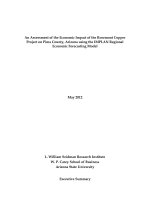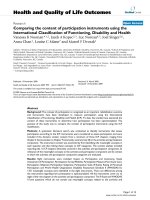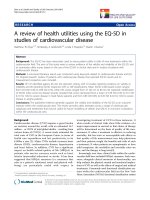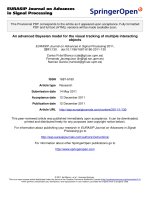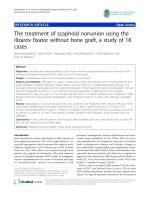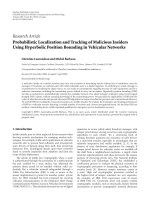Tracking of multiple objects using the PHD filter
Bạn đang xem bản rút gọn của tài liệu. Xem và tải ngay bản đầy đủ của tài liệu tại đây (2.47 MB, 156 trang )
TRACKING OF MULTIPLE OBJECTS USING
THE PHD FILTER
PHAM NAM TRUNG
(B.Sc., University of Natural Science, Ho Chi Minh City, Vietnam)
A THESIS SUBMITTED
FOR THE DEGREE OF DOCTOR OF PHILOSOPHY
DEPARTMENT OF ELECTRICAL AND COMPUTER
ENGINEERING
NATIONAL UNIVERSITY OF SINGAPORE
2007
Acknowledgements
I would like to express my deep and sincere gratitude to my supervisors, Professor
Sim Heng Ong, Dr. Weimin Huang, Dr. Jian Kang Wu, and Dr. Tele Tan. Their
wide knowledge has been of great value for me. Their understanding, encouraging
and personal guidance have provided contributions for the present thesis.
I am deeply grateful to Professor Wing Kin Ma for his program codes on
multiple-speaker tracking.
I warmly thank Mr. Ya Dong Wang for his valuable discussions during the time
I spent at Institute for Infocomm Research.
I also wish to thank my friends at Singapore, my family for their sympathising
and encouraging me to …nish this work.
ii
iii
I owe my loving thanks to my girl friend Nguyen Thi Kim Tuyen for her encour-
aging, understanding, and loving support when I am studying abroad in Singapore.
I am grateful to both National University of Singapore and Institute for In-
focomm Research for their generous …nancial assistance during my postgraduate
study.
I would like to give my thanks for using the facility of Star Home [1] for data
capturing of testing.
Last but not least, I gratefully acknowledge the support that was provided
under EU project ASTRALS (FP6-IST-0028097).
Abstract
The random set approach opens a new direction for multiple-sensor multiple-object
tracking. All aspects related to objects such as appearing, disappearing, moving,
measurements, and clutter can be modeled by random …nite sets. The probability
hypothesis density (PHD) …lter, proposed by Mahler, operates on a single-object
state space and avoids the data association problem. Multiple-object tracking is
thus made more practical but we need to formulate the problem under the random
…nite set framework to use the PHD …lter in applications. These formulations are
not straight-forward.
In this thesis, we investigated methods based on the PHD …lter for multiple-
object tracking. The contributions of this thesis include:
iv
v
1) Proposing a method to maintain the track continuity in the PHD …lter in Chap-
ter 4. The method can be used to track multiple objects in applications with high
density of clutter and varying number of objects that traditional methods such as
JPDA or MHT …nd di¢ cult to handle because of the computational complexity.
2) Giving an e¢ cient method for multiple-speaker tracking using the PHD …lter in
Chapter 5. Our method is less computational and more reliable than some meth-
ods for multiple-speaker tracking. The proposed method is e¢ cient for real time
tracking of multiple speakers in a reverberant room.
3) Improving the performance of multiple-object tracking in video by using the
PHD …lter in Chapter 6. A PHD recursion for visual observations with color mea-
surements is proposed. With this approach, the video tracking can work for varying
number of objects in single-object state space. Moreover, we extend the method
in multiple-camera multiple-object tracking with good performance in Chapter 7.
The experimental results in this thesis show that the PHD …lter is a promising
approach for multiple-object tracking applications.
List of Tables
6.1 Error of estimation . . . . . . . . . . . . . . . . . . . . . . . . . . . 97
7.1 Error of 3D estimation . . . . . . . . . . . . . . . . . . . . . . . . . 112
vi
List of Figures
2.1 Typical components of an object tracking system . . . . . . . . . . 12
2.2 Particle …lter . . . . . . . . . . . . . . . . . . . . . . . . . . . . . . 17
3.1 Particle PHD …lter . . . . . . . . . . . . . . . . . . . . . . . . . . . 36
4.1 An example when two objects are close . . . . . . . . . . . . . . . . 42
4.2 Label association for the GMPHD …lter . . . . . . . . . . . . . . . . 45
4.3 An example for wrong matching . . . . . . . . . . . . . . . . . . . . 46
4.4 Hungarian algorithm for label association . . . . . . . . . . . . . . . 47
4.5 Track continuity with the method in [21] . . . . . . . . . . . . . . . 50
4.6 Track continuity with our method . . . . . . . . . . . . . . . . . . . 51
4.7 Track continuity with the method in [21] . . . . . . . . . . . . . . . 52
vii
List of Figures viii
4.8 Track continuity with our method . . . . . . . . . . . . . . . . . . . 53
4.9 Mean number of labels for tracks of our method and the method in
[21] . . . . . . . . . . . . . . . . . . . . . . . . . . . . . . . . . . . . 54
5.1 TDOA measurements for multiple speaker tracking . . . . . . . . . 67
5.2 Position (x; y) of objects with measurements from sensor 1 . . . . . 71
5.3 Position (x; y) of objects with measurements from sensor 2 . . . . . 72
5.4 Position (x; y) of objects with the fusion method . . . . . . . . . . . 73
5.5 Position (x; y) of speakers with the particle …lter in [98] . . . . . . . 74
5.6 Number of speakers by the particle PHD …lter . . . . . . . . . . . . 75
5.7 Position (x; y) of speakers with the particle PHD …lter . . . . . . . 75
5.8 Number of speakers by the RFS-SMC Bayes …lter . . . . . . . . . . 76
5.9 Position (x; y) of speakers with the RFS-SMC Bayes …lter . . . . . . 77
5.10 Number of speakers by the GMPHD …lter . . . . . . . . . . . . . . 78
5.11 Position (x; y) of sp eakers with the GMPHD …lter . . . . . . . . . . 79
5.12 Probability of correct speaker number . . . . . . . . . . . . . . . . . 81
5.13 Absolute error on the number of speaker . . . . . . . . . . . . . . . 81
5.14 Conditional mean distance error of multiple-speaker tracking . . . . 82
6.1 PHD recursion for color multiple-object tracking . . . . . . . . . . . 92
6.2 Comparison between our method (left) and the boosted particle …l-
ter (right) . . . . . . . . . . . . . . . . . . . . . . . . . . . . . . . . 98
List of Figures ix
6.3 Tracking multiple players in the football sequence . . . . . . . . . . 99
6.4 Tracking multiple persons in seq16 . . . . . . . . . . . . . . . . . . 101
7.1 An example for wrong matching based on the apperance . . . . . . 104
7.2 The sketch of our system for multiple object tracking using multiple
cameras . . . . . . . . . . . . . . . . . . . . . . . . . . . . . . . . . 106
7.3 Sequential updating for PHD at cameras . . . . . . . . . . . . . . . 109
7.4 3D results of tracking multiple people using the PHD …lter . . . . . 114
7.5 Projection 3D estimations to two camera planes . . . . . . . . . . . 116
7.6 3D results of tracking multiple people using Stereo Matching . . . . 117
7.7 Some frame results from the Stereo Matching method . . . . . . . . 118
7.8 Some frame results from our method . . . . . . . . . . . . . . . . . 119
7.9 3D results of tracking multiple people in sequence 1 . . . . . . . . . 120
7.10 3D results of tracking multiple people in sequence 2 . . . . . . . . . 121
Contents
List of Tables vi
List of Figures vii
1 Introduction 5
1.1 Motivation . . . . . . . . . . . . . . . . . . . . . . . . . . . . . . . . 5
1.2 Major contributions . . . . . . . . . . . . . . . . . . . . . . . . . . . 7
1.3 Organization of thesis . . . . . . . . . . . . . . . . . . . . . . . . . . 9
2 Review of object tracking 11
2.1 Introduction to object tracking . . . . . . . . . . . . . . . . . . . . 11
2.2 Single-object tracking by the Bayes …lter . . . . . . . . . . . . . . . 12
1
Contents 2
2.3 Kalman …lter . . . . . . . . . . . . . . . . . . . . . . . . . . . . . . 14
2.4 Particle …lter . . . . . . . . . . . . . . . . . . . . . . . . . . . . . . 16
2.5 Multiple-object tracking . . . . . . . . . . . . . . . . . . . . . . . . 18
2.6 Multiple hypothesis tracking . . . . . . . . . . . . . . . . . . . . . . 20
2.7 Joint probabilistic data association . . . . . . . . . . . . . . . . . . 21
2.8 Multiple-object tracking with visual data . . . . . . . . . . . . . . . 24
2.9 Multiple-speaker tracking . . . . . . . . . . . . . . . . . . . . . . . . 25
2.10 Summary . . . . . . . . . . . . . . . . . . . . . . . . . . . . . . . . 26
3 Probability hypothesis density …lter 27
3.1 Introduction . . . . . . . . . . . . . . . . . . . . . . . . . . . . . . . 27
3.2 Random …nite set Bayesian …lter for multiple-object tracking . . . 28
3.3 Probability hypothesis density (PHD) …lter . . . . . . . . . . . . . . 31
3.4 Particle PHD …lter . . . . . . . . . . . . . . . . . . . . . . . . . . . 34
3.5 Gaussian mixture probability hypothesis density (GMPHD) …lter . 35
3.6 Summary . . . . . . . . . . . . . . . . . . . . . . . . . . . . . . . . 39
4 Maintaining track continuity in the GMPHD …lter 40
4.1 Introduction . . . . . . . . . . . . . . . . . . . . . . . . . . . . . . . 40
4.2 GMPHD …lter with label association . . . . . . . . . . . . . . . . . 42
4.3 Matching with minimum total distance for label association . . . . 44
4.4 Simulation experiments . . . . . . . . . . . . . . . . . . . . . . . . . 47
Contents 3
4.5 Summary . . . . . . . . . . . . . . . . . . . . . . . . . . . . . . . . 55
5 Multiple-speaker tracking using the PHD …lter 56
5.1 Introduction . . . . . . . . . . . . . . . . . . . . . . . . . . . . . . . 56
5.2 Random …nite set for multiple-sensor multiple-object tracking . . . 59
5.3 Gaussian mixture probability hyp othesis density …lter with multiple
sensors . . . . . . . . . . . . . . . . . . . . . . . . . . . . . . . . . . 61
5.3.1 Assumptions . . . . . . . . . . . . . . . . . . . . . . . . . . . 61
5.3.2 GMPHD …lter with multiple sensors . . . . . . . . . . . . . 62
5.3.3 Implementation issues . . . . . . . . . . . . . . . . . . . . . 64
5.4 Time delay of arrival measurement for multiple-speaker tracking . . 65
5.5 GMPHD …lter for multiple-speaker tracking . . . . . . . . . . . . . 67
5.6 Experimental results . . . . . . . . . . . . . . . . . . . . . . . . . . 68
5.6.1 GMPHD …lter with multiple sensors for bearing and range
tracking . . . . . . . . . . . . . . . . . . . . . . . . . . . . . 68
5.6.2 GMPHD …lter for multiple-speaker tracking . . . . . . . . . 71
5.7 Summary . . . . . . . . . . . . . . . . . . . . . . . . . . . . . . . . 82
6 Multiple-object tracking using the PHD …lter and color measure-
ments 84
6.1 Introduction . . . . . . . . . . . . . . . . . . . . . . . . . . . . . . . 84
6.2 Color likelihood . . . . . . . . . . . . . . . . . . . . . . . . . . . . . 87
Contents 4
6.3 Random …nite set formulation for color object tracking . . . . . . . 88
6.4 Hypothesis intensity function for color tracking . . . . . . . . . . . 89
6.5 GMPHD …lter for color multiple-object tracking . . . . . . . . . . . 91
6.6 Experimental results . . . . . . . . . . . . . . . . . . . . . . . . . . 96
6.7 Summary . . . . . . . . . . . . . . . . . . . . . . . . . . . . . . . . 100
7 Multiple-camera multiple-object tracking using the PHD …lter 102
7.1 Introduction . . . . . . . . . . . . . . . . . . . . . . . . . . . . . . . 102
7.2 System overview . . . . . . . . . . . . . . . . . . . . . . . . . . . . 105
7.3 Single-view tracking . . . . . . . . . . . . . . . . . . . . . . . . . . 106
7.4 Multiple-camera fusion . . . . . . . . . . . . . . . . . . . . . . . . 108
7.5 Experimental results . . . . . . . . . . . . . . . . . . . . . . . . . . 111
7.6 Summary . . . . . . . . . . . . . . . . . . . . . . . . . . . . . . . . 122
8 Conclusion and future work 123
Chapter 1
Introduction
1.1 Motivation
Object tracking is an important part of many applications, such as sports analysis
[28], [72], surveillance [91], smart ro om [70], robot control [69], human computer
interaction [12], and video conferencing [27]. It allows us to determine the states
of objects and helps us in analyzing their behaviors. Because of the importance
of object tracking, there are many researchers working in this area. Some of them
have proposed approaches for tracking a single object [11], [83], [110]. However, in
many applications, there are more than one object. There are many approaches
for multiple-object tracking. Traditional approaches are based on data associa-
tion between objects and measurements such as time delay of arrival, and range
from sensors [6], [80]. If this data association is known in advance, the problem of
5
1.1 Motivation 6
multiple-object tracking becomes one of tracking independent single objects. Oth-
erwise, we need to consider the data association problem. This is because when
the data association is not correct, the state estimates are not reliable. There are
some approaches to data association problem such as multiple hypothesis tracking
(MHT) [80] and joint probabilistic data association (JPDA) [6], [85]. However, the
determination of association probabilities in these methods is an NP-hard problem
[71].
There has been increasing research interest on using the random set theory
for multiple-object tracking [37], [63]. In the random set approach, the states
of objects, measurements, and clutter are modeled by random sets. Mahler [63]
presented a probability hypothesis density (PHD) …lter for multiple-object tracking
by using the random set framework. This method operates on a single-object state
space and avoids the combinatorial problem that arises from the data association
between objects and measurements. Thus, the computation of the PHD …lter
is less than traditional methods such as MHT, and JPDA. The low cost of the
computation in the PHD …lter makes the random set approach more promising for
multiple-object tracking applications.
In this thesis, we focus on multiple-object tracking by using the random set
approach and concentrate on practical issues when using the PHD …lter in ap-
plications. Through experimental results on applications, we also show that the
PHD …lter can handle non-trivial tasks in multiple-object tracking such as data
1.2 Major contributions 7
association, varying number of objects, multiple-sensor data fusion, and clutter
handling.
1.2 Major contributions
The major contributions of this thesis are to develop methods using the PHD …lter
for multiple-object tracking in several directions:
A reliable method to maintain the track continuity in the PHD …lter.
A reliable method to maintain the track continuity in the PHD …lter is pro-
posed. The track continuity is determined by the Hungarian algorithm. This
is an exact method to determine the data association b etween tracks of the
previous and the current time steps. The proposed method is more reliable
than using heuristic metho ds to maintain track continuity. This method
might be important for multiple-object tracking with high density of clutters
and varying number of objects that traditional methods such as MHT and
JPDA …nd di¢ cult to handle. This is because the computational complexity
of MHT and JPDA are known as NP-hard while the computational com-
plexity of the PHD …lter is O (jZj N), where jZj is the maximum number
of measurements, and N is the maximum number of Gaussian components
(for the Gaussian mixture PHD …lter) or number of samples (for the particle
PHD …lter).
1.2 Major contributions 8
An e¢ cient method for multiple-speaker tracking
An e¢ cient technique for real-time tracking of multiple speakers in a rever-
berant room is proposed. To have an e¢ cient method for multiple-speaker
tracking, fusing measurements from microphone pairs with low cost of com-
putation and high performance is a critical and challenging step. In this
thesis, we fuse the time delay of arrival measurements in the Gaussian mix-
ture probability hypothesis density …lter. The method is more reliable and
computationally tractable than some methods for multiple-speaker tracking.
Moreover, our approach can be applied to other multiple-sensor multiple-
object applications such as bearing and range tracking, and multiple-camera
multiple-object tracking.
A method using the PHD …lter for color object tracking.
When using the PHD …lter, representing measurements as random sets is a
mandatory step. Unfortunately, representing color measurements as random
sets is a di¢ cult task. We propose a method to obtain the color measurement
random set and apply it in the PHD …lter for color object tracking. It tracks
multiple objects with video data in single-object state space. Moreover, it
may be important in other applications, such as track-before-detect, where
it is di¢ cult to obtain a measurement random set.
A method for multiple-camera multiple-object tracking using the PHD …lter.
1.3 Organization of thesis 9
Tracking multiple objects in a multiple-camera environment is a challenging
task. This is because of the data association of objects among cameras in
the high dimensional state space. We propose a method for multiple-camera
multiple-object tracking using the PHD …lter. This method can track 3D
object locations even when objects are undergoing complex interaction with
multiple occlusions and merge-split in groups. Moreover, it avoids data as-
sociation and tracks multiple objects in single-object state space. In the
proposed method, both temporal and visual information are considered.
1.3 Organization of thesis
The organization of this thesis is as follows.
Chapter 2: A literature review on object tracking by …ltering approaches
is given. This chapter discusses fundamentals of object tracking and data
association for multiple-object tracking.
Chapter 3: This chapter contains an introduction on the PHD …lter. Random
set formulations of multiple-object tracking are described. Implementations
of the PHD …lter such as the particle PHD …lter, the Gaussian mixture PHD
…lter are also discussed.
Chapter 4: The metho d for maintaining the track continuity in the PHD
1.3 Organization of thesis 10
…lter is presented. Simulation resutls to show the e¢ ciency of the method is
detailed.
Chapter 5: The method for multiple-speaker tracking and the implementa-
tion issues are described. Simulation results and comparisons between our
method and others are shown to demonstrate the e¢ ciency of the method.
Chapter 6: A technique for tracking multiple objects by using the PHD …lter
and color measurements is proposed. Steps to obtain the color measurement
random set and the implementation of the method are described.
Chapter 7: A multiple-camera multiple-person tracking using the random
set approach is presented. The method includes two stages of single-view
tracking and multiple-camera fusion. These two stages are described and
promising experimental results of the proposed method are shown.
Chapter 8: This chapter summarizes contributions of our research and dis-
cusses future work.
Chapter 2
Review of object tracking
2.1 Introduction to object tracking
Tracking is the processing of measurements obtained from objects such as color
[28], contour [11], time delay of arrival [112], bearing and range [81] to obtain the
estimations of unknown object kinematics or states. The unknown object kinemat-
ics of interest are usually the position, velocity, and acceleration of the object in an
appropriate coordinate system. Some examples of tracking include radar tracking
of military vehicles [9], tracking of people for monitoring [41], surveillance systems
[90]. Figure 2.1 shows the components of a typical tracking process.
11
2.2 Single-object tracking by the Bayes …lter 12
Figure 2.1: Typical components of an object tracking system
There are various techniques for object tracking. For example, some techniques
transfer the tracking problem to a minimization problem by searching for the best
match of the object with the previous estimation as an initialization [23], [34].
Some other object tracking techniques use neural networks [3], [59], fuzzy logic
[94], and Bayes …lter [47]. However, Bayesian theory remains the most widely
accepted approach to object tracking.
2.2 Single-object tracking by the Bayes …lter
We consider the scenario in which a single object is present. We assume that the
state of object follows a Markov process on the state space X R
n
x
: Let x
k
be
the state of object at time k. The evolution of the state sequence of an object is
given by
x
k
= f
k
(x
k1
; w
k1
) (2.1)
2.2 Single-object tracking by the Bayes …lter 13
where f
k
is a transition function, w
k1
is the process noise. The probability density
of a transition from x
k1
to x
k
is f
kjk1
(x
k
jx
k1
).
This Markov process is partially observed in the observation space Z R
n
z
,
i.e., given a state x
k
at time k, the observation of an object is
z
k
= g
k
(x
k
; v
k
) (2.2)
where g
k
is a measurement function, v
k
is the measurement noise. The probability
density of receiving the observation z
k
given the state x
k
is g
k
(z
k
jx
k
). It is also
called the likelihood function.
The probability density of state x
k
at time k given all observations z
1:k
=
(z
1
; : : : ; z
k
) up to time k, denoted by
p
k
(x
k
jz
1:k
); (2.3)
is called the posterior density (or …ltering density) at time k. This posterior density
can be obtained by using the Bayes …lter. This …lter includes two steps. The …rst
step is called the prediction step. From the posterior density at the previous time
k 1, p
k1
(x
k1
jz
1:k1
); and the transition density f
kjk1
(x
k
jx
k1
), we can obtain
the predicted density p
kjk1
(x
k
jz
1:k1
) via the prediction equation
p
kjk1
(x
k
jz
1:k1
) =
Z
f
kjk1
(x
k
jx
k1
)p
k1
(x
k1
jz
1:k1
)dx
k1
(2.4)
The second part of the Bayes …lter is the updating step. From the predicted density
p
kjk1
(x
k
jz
1:k1
) and the likelihood function g
k
(z
k
jx
k
), the posterior density can be
2.3 Kalman …lter 14
obtained by
p
k
(x
k
jz
1:k
) =
g
k
(z
k
jx
k
)p
kjk1
(x
k
jz
1:k1
)
R
g
k
(z
k
jx
k
)p
kjk1
(x
k
jz
1:k1
)dx
k
(2.5)
The state of object ^x
kjk
can be estimated from the posterior density p
k
(x
k
jz
1:k
)
by taking either the maximum a posterior (MAP) estimation,
^x
MAP
kjk
= arg max
x
k
p
k
(x
k
jz
1:k
) (2.6)
or the expected a posteriori (EAP) estimation
^x
EAP
kjk
=
Z
xp
k
(xjz
1:k
)dx (2.7)
The EAP estimation is also the minimum mean square error (MMSE) estimation
of the state of object.
2.3 Kalman …lter
In linear systems with Gaussian noises, the Bayes …lter has a closed-form that is
proposed by Kalman [4]. This closed-form is called the Kalman …lter (KF). The
Kalman …lter assumes that the posterior density at every time step is a Gaussian
and hence parameterized by a mean and a covariance matrix. In linear systems
with Gaussian noises, if the posterior density at time k 1, p
k1
(x
k1
jz
1:k1
), is a
Gaussian, then the posterior density at time k, p
k
(x
k
jz
1:k
), is also a Gaussian. In
2.3 Kalman …lter 15
these cases, the state space model can be re-written as follows:
x
k
= F
k1
x
k1
+ w
k1
(2.8)
z
k
= H
k
x
k
+ v
k
(2.9)
where F
k1
is a transition matrix, H
k
is a measurement sensitive matrix, w
k1
N(0; Q
k1
) is the process noise and v
k
N(0; R
k
) is the measurement noise.
N(m; P ) is a Gaussian density with mean m and covariance P:
The Kalman …lter algorithm, derived by using (2.4) and (2.5), can be viewed
as the following recursive relationship:
p
k1
(x
k1
jz
1:k1
) = N
x
k1
; m
k1jk1
; P
k1jk1
(2.10)
p
kjk1
(x
k
jz
1:k1
) = N
x
k
; m
kjk1
; P
kjk1
(2.11)
p
k
(x
k
jz
1:k
) = N
x
k
; m
kjk
; P
kjk
(2.12)
where
m
kjk1
= F
k1
m
k1jk1
(2.13)
P
kjk1
= Q
k1
+ F
k1
P
k1jk1
F
T
k1
(2.14)
m
kjk
= m
kjk1
+ K
k
z
k
H
k
m
kjk1
(2.15)
P
kjk
= P
kjk1
K
k
H
k
P
kjk1
(2.16)
and where N (x; m; P) is a Gaussian density with argument x, mean m and co-
variance P and
K
k
= P
kjk1
H
T
k
H
k
P
kjk1
H
T
k
+ R
k
1
(2.17)
2.4 Particle …lter 16
In linear Gaussian systems, the Kalman …lter is an optimal solution to the
single-object tracking [4]. The implication is that no algorithm can do better than
the Kalman …lter in the linear Gaussian environment. If the system is not linear
Gaussian, there are some extension from the Kalman …lter such as the extended
Kalman …lter (EKF) [49] or the unscented Kalman …lter (UKF) [109] that can
be applied. The advantage of KF, EKF, UKF is the low computational burden.
However, they are not appropriate when the posterior density is a binomal or
multimodal probability density function.
2.4 Particle …lter
The particle …lter was …rst introduced by Gordon [38]. It is also known by dif-
ferent names, such as the condensation algorithm [46], the bo otstrap …lter [38],
and the Monte Carlo …lter [32]. The particle …lter has been developed to solve
non-Gaussian and non-linear problems. The key idea to solve non-Gaussian and
non-linear problems is to represent the posterior density function by a set of ran-
dom samples with associated weights and to compute estimates based on these
samples and weights. When the number of samples goes to in…nity, the particle
…lter will become the optimal Bayes …lter. The proof of convergence is found in
[25], [26]. The particle …lter is brie‡y described as follows.
Assume at time k 1, a set of weighted particles
n
w
(i)
k1
; x
(i)
k1
o
N
i=1
representing

